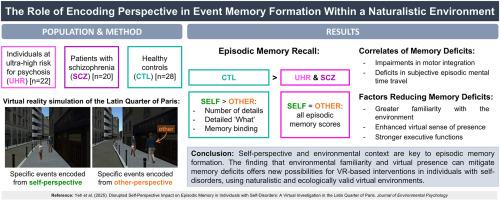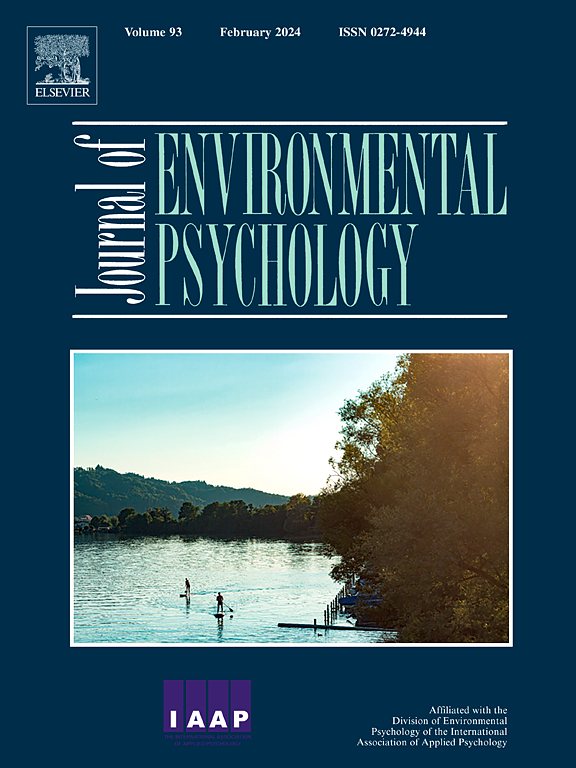自我视角中断对自我障碍个体情景记忆的影响:巴黎拉丁区的一项虚拟调查
IF 7
1区 心理学
Q1 ENVIRONMENTAL STUDIES
引用次数: 0
摘要
虚拟现实(VR)为研究情景记忆(EM)形成过程中环境因素与自我参照过程的相互作用提供了一个强有力的框架。本研究考察了在巴黎拉丁区进行现实模拟时,采用自我视角或他人视角是否会对精神病超高风险(UHR)个体(n = 22)、精神分裂症患者(SCZ;n = 20),健康对照组(CTL;n = 28)。参与者从他们自己的第一人称视角或角色的第三人称视角编码特定事件。导航后,他们完成了一项自由回忆任务,评估事实内容、时空背景和现象细节。结果表明,与他人角度相比,从自我角度编码事件时,CTL表现出自我参照效应,能够回忆更多的细节,并表现出增强的记忆绑定。相比之下,UHR和SCZ组表现出普遍的EM缺陷,无论视角如何,都缺乏这种自我参照优势。自我视角编码缺陷与神经软体征相关,而EM表现与情景性心理时间旅行、执行功能、存在感和环境熟悉度相关,表明环境、自我和记忆编码之间存在整合过程。这些发现支持了SCZ谱系中最小自我或不完整性中断的理论,表明第一人称锚定的核心改变损害了将经验编码为连贯的、空间情境化的情景记忆。此外,研究结果强调了自然环境对于揭示自我指涉和环境因素如何共同塑造精神病患者记忆的重要性。基于虚拟现实的方法可能有助于早期识别高危个体,并为有针对性的干预提供信息,以促进与环境的接触,增强临床人群的EM和自我相关过程。本文章由计算机程序翻译,如有差异,请以英文原文为准。

Disrupted self-perspective impact on episodic memory in individuals with self-disorders: A virtual investigation in the Latin Quarter of Paris
Virtual reality (VR) provides a powerful framework for investigating how environmental factors interact with self-referential processes during episodic memory (EM) formation. This study examined whether adopting a self-perspective or another person's perspective while navigating a realistic simulation of the Latin Quarter of Paris differentially influenced EM in individuals at ultra-high risk (UHR) for psychosis (n = 22), patients with schizophrenia (SCZ; n = 20), and healthy controls (CTL; n = 28). Participants encoded specific events from either their own first-person perspective or an avatar's third-person perspective. After the navigation, they completed a free recall task assessing factual content, spatiotemporal context, and phenomenological details. Results showed that CTL exhibited a self-reference effect, recalling more details and demonstrating enhanced memory binding when encoding events from a self-perspective, compared to an other-perspective. In contrast, UHR and SCZ groups displayed pervasive EM deficits regardless of perspective and lacked this self-referential advantage. Deficits in self-perspective encoding correlated with neurological soft signs, while EM performance was associated with episodic mental time travel, executive functions, sense of presence and environmental familiarity, suggesting integrative processes between the environment, Self, and memory encoding. These findings support the theory of a disruption of minimal selfhood or ipseity in the SCZ spectrum, suggesting that core alterations in first-person anchoring compromise the encoding of experiences into coherent, spatially contextualised episodic memories. Furthermore, the results highlight the importance of naturalistic settings for uncovering how self-referential and environmental factors jointly shape memory in psychosis. VR-based approaches may facilitate early identification of at-risk individuals and inform targeted interventions to promote engagement with the environment, enhancing EM and self-related processes in clinical populations.
求助全文
通过发布文献求助,成功后即可免费获取论文全文。
去求助
来源期刊

Journal of Environmental Psychology
Multiple-
CiteScore
10.60
自引率
8.70%
发文量
140
审稿时长
62 days
期刊介绍:
The Journal of Environmental Psychology is the premier journal in the field, serving individuals in a wide range of disciplines who have an interest in the scientific study of the transactions and interrelationships between people and their surroundings (including built, social, natural and virtual environments, the use and abuse of nature and natural resources, and sustainability-related behavior). The journal publishes internationally contributed empirical studies and reviews of research on these topics that advance new insights. As an important forum for the field, the journal publishes some of the most influential papers in the discipline that reflect the scientific development of environmental psychology. Contributions on theoretical, methodological, and practical aspects of all human-environment interactions are welcome, along with innovative or interdisciplinary approaches that have a psychological emphasis. Research areas include: •Psychological and behavioral aspects of people and nature •Cognitive mapping, spatial cognition and wayfinding •Ecological consequences of human actions •Theories of place, place attachment, and place identity •Environmental risks and hazards: perception, behavior, and management •Perception and evaluation of buildings and natural landscapes •Effects of physical and natural settings on human cognition and health •Theories of proenvironmental behavior, norms, attitudes, and personality •Psychology of sustainability and climate change •Psychological aspects of resource management and crises •Social use of space: crowding, privacy, territoriality, personal space •Design of, and experiences related to, the physical aspects of workplaces, schools, residences, public buildings and public space
 求助内容:
求助内容: 应助结果提醒方式:
应助结果提醒方式:


